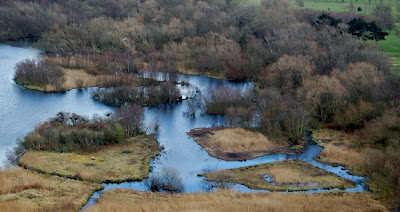On the road to Duddingston
Blogging can often surprise you, taking you on adventures you had never expected. It’s especially rewarding when you get the chance to meet and even work with folks you admire.
I’ve long been a fan of the Pocket Mountains books, a series of handy wee guides to Scotland comprised mostly of town and country walks in various areas of the country.
The publishers are aiming to refresh their Edinburgh edition next year, so I’m going to be doing the walks, making notes and just ensuring the routes are still open and clear. Of course, if I have to go on 40 town and country walks, you’re all coming with me.
Our first foray is walk #14, “Radical Road from Duddingston,” which starts at the foot of the hills in Holyrood Park.
Our half-way point and the highlight of the trip is the quaint village of Duddingston, home of Scotland’s oldest surviving public house.
The welcome glow of green is starting to show through on the hills, and on the trees the buds seem to be desperate to burst. All the same, the long descent into Duddingston brings a welcome break from the sometimes chilly wind that continues to whip over the open areas.
The first thing that is likely to draw a visitor upon entering Duddingston is the Kirk, which sits on a high slope overlooking Duddingston Loch. Founded in the 12th century by a Norman knight, it has undergone a number of changes over the centuries.
This included the addition of a separate gatehouse meant to keep out 19th century body snatchers, who were intent on selling fresh corpses for medical research.
Still attached to the stone wall outside the Kirk are “jougs” or stocks, where criminals suffered the punishment of being held by an iron collar, on display for all the faithful to see.
If you’re like me you’ll wander the yard at least once, looking for unique gravestones. Against one wall, a small Celtic cross bears a sad, simple proclamation in memory of “Wee Jim.”
Leave the Kirk to take a stroll down to Duddingston Loch and try to imagine the Reverend Walker, balanced and stoic on his skates in what has become one of Scotland’s most famous paintings.
Finally, I think we’ve earned the right to hoist a pint in the spot which has been home to a pub since 1360. We’re off to The Sheep Heid Inn. The story goes that King James IV of Scotland gave the innkeeper an ornate ram’s head snuff box in 1580, giving the inn its name.
The light was too dim for indoor photos, so you will just have to imagine the dark wood, the low, heavy-beamed ceiling and the walls cluttered with old clocks all stopped at different times, brass pots and pans, and of course, a collection of mounted sheep heads.
For those with a love of the macabre, take yourself back to 1724. You’re tucked in at a table at the busy inn, where a fire is roaring and a closed coffin is on display. This is the funeral of Maggie Dickson, who has just been hung for infanticide.
As you sit nursing your drink, the room goes silent as banging and scratching sounds start to come from inside the coffin. The lid is lifted and Maggie is found still alive. She goes on to make a complete recovery and becomes known as “Half-Hangit Maggie.”
The downside to surviving her hanging? Since she had been pronounced dead, she had to remarry her “widower” husband.
We both loved The Sheep Heid Inn. This is one of the best things about Scotland -these small local places which have been central to village life for centuries. This is the kind of place that can change a visit to Edinburgh from simply pleasant to truly memorable.
Now that you’re sloshing with food and drink, you’ll have to haul yourself uphill over The Radical Road, a stony path built by unemployed weavers in the 1820s. The project was made at the suggestion of none other than Sir Walter Scott, and the reward for putting one foot in front of the other are the magnificent views of Edinburgh Castle and an opportunity to get up-close to the unique geological features of Salisbury Crags.
Overall, I thought this walk was excellent. Keep in mind the trails can sometimes be muddy and I would caution those with bad knees that the final descent down Salisbury Crags can be a bit sore. However, for ease of access from the city centre to the variety of natural and historical features, I would give this an enthusiastic 9/10.
Only 39 walks to go!
**************
Blog news: Some of you may have noticed the addition of a wee donate button in the sidebar of this blog. For the past two years I have kept this blog advert free, but this is something I am currently considering to help keep me going on these adventures that I love. “The bacon buttie fund,” as I have named it, is there to give people the opportunity to support me if they value the work I am doing.
Thanks again for reading. Squeeze.




















